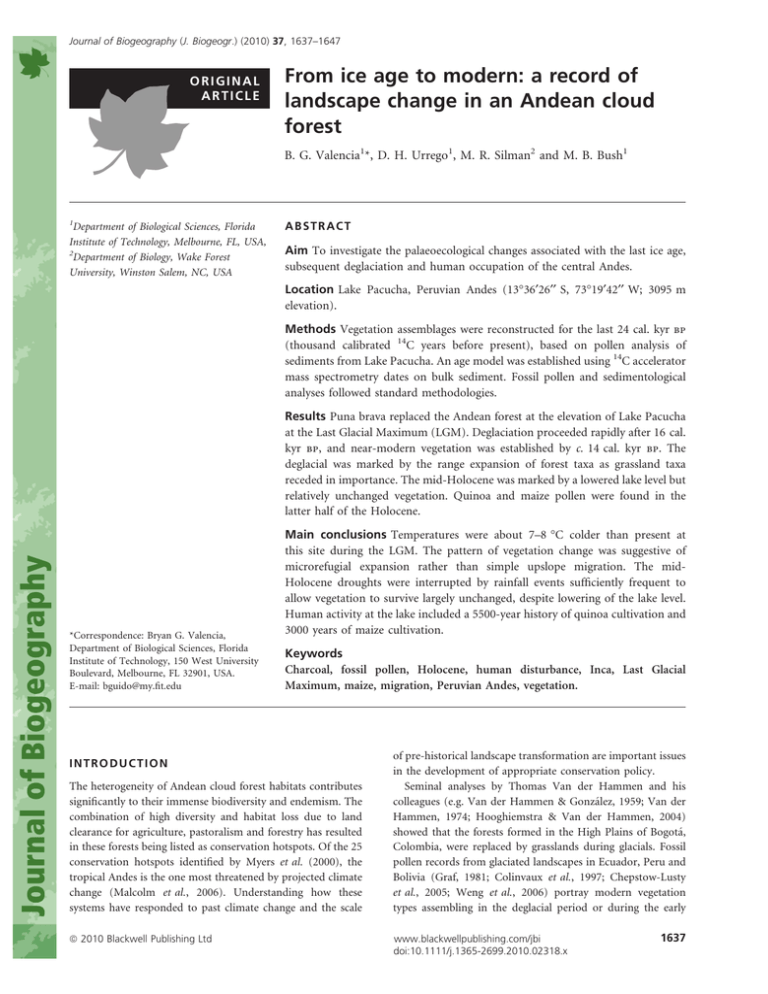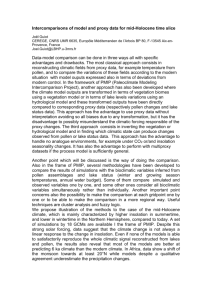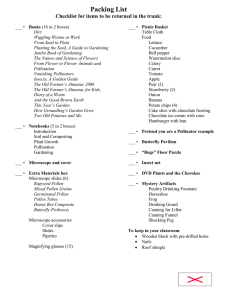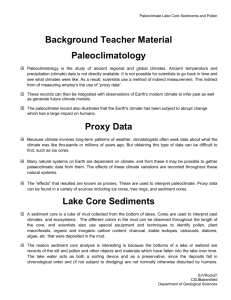From ice age to modern: a record of forest
advertisement

Journal of Biogeography (J. Biogeogr.) (2010) 37, 1637–1647 ORIGINAL ARTICLE From ice age to modern: a record of landscape change in an Andean cloud forest B. G. Valencia1*, D. H. Urrego1, M. R. Silman2 and M. B. Bush1 1 Department of Biological Sciences, Florida Institute of Technology, Melbourne, FL, USA, 2 Department of Biology, Wake Forest University, Winston Salem, NC, USA ABSTRACT Aim To investigate the palaeoecological changes associated with the last ice age, subsequent deglaciation and human occupation of the central Andes. Location Lake Pacucha, Peruvian Andes (1336¢26¢¢ S, 7319¢42¢¢ W; 3095 m elevation). Methods Vegetation assemblages were reconstructed for the last 24 cal. kyr bp (thousand calibrated 14C years before present), based on pollen analysis of sediments from Lake Pacucha. An age model was established using 14C accelerator mass spectrometry dates on bulk sediment. Fossil pollen and sedimentological analyses followed standard methodologies. Results Puna brava replaced the Andean forest at the elevation of Lake Pacucha at the Last Glacial Maximum (LGM). Deglaciation proceeded rapidly after 16 cal. kyr bp, and near-modern vegetation was established by c. 14 cal. kyr bp. The deglacial was marked by the range expansion of forest taxa as grassland taxa receded in importance. The mid-Holocene was marked by a lowered lake level but relatively unchanged vegetation. Quinoa and maize pollen were found in the latter half of the Holocene. *Correspondence: Bryan G. Valencia, Department of Biological Sciences, Florida Institute of Technology, 150 West University Boulevard, Melbourne, FL 32901, USA. E-mail: bguido@my.fit.edu Main conclusions Temperatures were about 7–8 C colder than present at this site during the LGM. The pattern of vegetation change was suggestive of microrefugial expansion rather than simple upslope migration. The midHolocene droughts were interrupted by rainfall events sufficiently frequent to allow vegetation to survive largely unchanged, despite lowering of the lake level. Human activity at the lake included a 5500-year history of quinoa cultivation and 3000 years of maize cultivation. Keywords Charcoal, fossil pollen, Holocene, human disturbance, Inca, Last Glacial Maximum, maize, migration, Peruvian Andes, vegetation. INTRODUCTION The heterogeneity of Andean cloud forest habitats contributes significantly to their immense biodiversity and endemism. The combination of high diversity and habitat loss due to land clearance for agriculture, pastoralism and forestry has resulted in these forests being listed as conservation hotspots. Of the 25 conservation hotspots identified by Myers et al. (2000), the tropical Andes is the one most threatened by projected climate change (Malcolm et al., 2006). Understanding how these systems have responded to past climate change and the scale ª 2010 Blackwell Publishing Ltd of pre-historical landscape transformation are important issues in the development of appropriate conservation policy. Seminal analyses by Thomas Van der Hammen and his colleagues (e.g. Van der Hammen & González, 1959; Van der Hammen, 1974; Hooghiemstra & Van der Hammen, 2004) showed that the forests formed in the High Plains of Bogotá, Colombia, were replaced by grasslands during glacials. Fossil pollen records from glaciated landscapes in Ecuador, Peru and Bolivia (Graf, 1981; Colinvaux et al., 1997; Chepstow-Lusty et al., 2005; Weng et al., 2006) portray modern vegetation types assembling in the deglacial period or during the early www.blackwellpublishing.com/jbi doi:10.1111/j.1365-2699.2010.02318.x 1637 Holocene. However, none offers a complete unbroken sequence from the Last Glacial Maximum (LGM) to the present. Lake Titicaca (Paduano et al., 2003; Hanselman et al., 2005; Fritz et al., 2007) provides a continuous record of puna and super puna that spans four glacial cycles, but cloud forest never occupied the site. At lower elevations, lakes Consuelo (Bush et al., 2004; Urrego et al., 2005) and Chaplin (Mayle et al., 2000) are continuous sequences that reflect the downslope expansion of cold taxa during the full glacial, but lose the upper cloud forest elements in the mid-deglacial period, c. 15 cal. kyr bp (henceforth all ages are expressed as thousand calibrated 14C years before present; cal. kyr bp). From these records a clear understanding has emerged that cloud forest ecosystems have been subject to migration as glacials lowered temperatures by c. 5–8 C in these settings (Van der Hammen, 1974). A fossil pollen record from Siberia, Bolivia, suggested that variability in precipitation was the dominant force shaping Andean ecosystems over the last 28 cal. kyr bp (Mourguiart & Ledru, 2003). Moreover, precipitation was influenced by precessional forcing that induced fluctuations in lake level in the lakes of the Altiplano (Baker et al., 2001a), central Peru (Seltzer et al., 2002), and (with opposing signature) the lakes of the High Plains of Bogotá (Hooghiemstra et al., 1993). An analysis of the diatom record of Lake Pacucha, Peru, demonstrated the presence of a precessional signal that underlay early Holocene drying c. 16–9 cal. kyr bp, but that a second period of low lake levels between c. 8.2 and 6 cal. kyr bp probably had a different explanation (Hillyer et al., 2009). The mid-Holocene dry event caused lake levels to fall throughout the Andes (Abbott et al., 2003). In much of the Altiplano and the Chilean Andes this period became known as the Zone of Archaeological Silence (Núñez et al., 2002) as so many sites appear to have been abandoned. However, the complex structure of this event has only recently been resolved as not being a continuous period of drought but one that was exceedingly drought-prone, with intervening wet intervals (Ekdahl et al., 2008; Hillyer et al., 2009). Ecologically, the difference between a millennial-scale drought versus one interrupted by intermittent moisture would have been huge and worthy of exploration. The greatest single ecological variable in modern Andean ecosystems is the presence or absence of fire. Cloud forests below the immediate contact with puna seldom burn naturally (Bush et al., 2005), and even a single fire can have transformative effects (Cochrane & Laurance, 2002; Cochrane & Barber, 2009). Fire can depress the tree line and totally eliminate the shrubby transition between forest and grassland (M. B. Bush, pers. obs). Where humans are actively burning the landscape, exotic species such as Pinus and Eucalyptus are often planted. It has been suggested that afforestation with native species has ancient roots in the Andes and that the Huari, and later the Inca, may have practised silviculture as much as 1000 years ago (Chepstow-Lusty & Winfield, 2000). Polylepis forms a native woodland that is particularly susceptible to fire (Cierjacks et al., 2008). This tree can occur above the tree line, with some individuals growing at an elevation of more than 5000 m (Kessler, 1995). However, Polylepis is most abundant on scree slopes and areas where fire is rare. Whether such a constrained occurrence for this genus is a purely recent pattern of growth is uncertain. Based on bioclimatic tolerances and a rich endemic fauna associated with these woodlands, it has been suggested that Polylepis woodland may have been a dominant vegetation type across large expanses of what are now puna grasslands (Ellenberg, 1958; Kessler, 1995; Fjeldså & Kessler, 1996). Interest in afforestation with native species as a win–win solution that provides carbon sequestration and conservation habitat has led to large-scale planting of Polylepis. Our research hypotheses to be tested are: (1) during the LGM plant species grew c. 1000–1500 m downslope of their present range, i.e. become puna if burned or Polylepis if unburned; (2) during deglaciation there was a steady migration of taxa upslope; (3) the mid-Holocene dry event would Cloud forest history: from ice age to modern Figure 1 A sketch map of Peru redrawn from Hillyer et al. (2009) showing the location of Lake Pacucha relative to lakes Consuelo, Marcacocha and Titicaca. The star represents the coring site and the depth-isoclines are expressed in metres. from genera that produce a lot of pollen, e.g. Podocarpus, Hedyosmum, Alnus, Weinmannia and Vallea, while even at the family level some important components are virtually silent in the pollen record, e.g. Lauraceae and Rubiaceae. Above the tree line, a thin band of shrubs is often dominated by Melastomataceae, Ericaceae and Asteraceae (Young, 1998), while above 3700 m puna grasses and herbs generally dominate the landscape. Puna extends upslope and becomes puna brava at an elevation of c. 4300–4500 m. MATERIALS AND METHODS Between 2003 and 2005, a series of cores were raised from the deepest portion of Lake Pacucha using a modified Colinvaux– Vohnout piston corer (Colinvaux et al., 1999) deployed from a floating platform. Bedrock was not reached, rather we hit the functional limit of a lightweight drilling rig with 45 m of drillstring deployed. Three cores (PAC-B, 11 m long; PAC-D, 11 m long; and PAC-E, 14.5 m long) were scanned for density at 0.5 cm (gamma attenuation) using a GEOTEK multi-sensor core logger (GEOTEK Ltd, Daventry, Northants, UK) at the University of Florida. Split cores were described (see Appendix S1 in Supporting Information) and scanned to acquire high-resolution digital colour images. The three cores were then aligned and cross-correlated to form a continuous 14.3-m long core. The core chronology was established using 14C accelerator mass spectrometry dates on bulk sediment avoiding carbonate sections (Hillyer et al., 2009; Appendix S2). Ages were calibrated based on Stuiver & Reimer (1993) and Stuiver et al. (2005) for dates < 11,000 years ago, and using Fairbanks et al. (2005) for those that were older. Journal of Biogeography 37, 1637–1647 ª 2010 Blackwell Publishing Ltd Loss-on-ignition samples were placed in weighed crucibles, and reweighed following 12 h at 105 C, 4 h at 550 C and 2 h at 950 C (Heiri et al., 2001). Subsamples for pollen were taken at 5-cm intervals throughout much of the core, and at 2-cm intervals in the upper 0.5 m. Pollen preparation followed standard protocols, including the use of Lycopodium spores to facilitate calculations of pollen concentration (Stockmarr, 1972; Faegri & Iversen, 1989). Three hundred terrestrial pollen grains were counted in each sample. A total of 158 subsamples were analysed for fossil pollen and 116 for fossil charcoal. Samples were heated in KOH before being filtered at 180 lm (after Clark & Royall, 1996). The residue was searched for charcoal and all pieces were documented and measured using an Olympus stereoscope at ·20 equipped with a digital camera, and the images were analysed using ImageJ software (Rasband, 2005). The resulting diagrams were plotted using C2 (Juggins, 1991). Ordination of data was completed using the version of detrended correspondence analysis (DCA) (Hill, 1979) available in pcord-4 (McCune & Grace, 2002). The ordination was run on the 47 taxa that attained > 0.5% in any sample or that occurred in at least 10 samples (after Birks & Gordon, 1985). RESULTS Stratigraphy and chronology The chronology and stratigraphy of the 14.3-m long record from Lake Pacucha has previously been published (Hillyer et al., 2009). We provide a core description and the 14C ages and calibrations in Appendices S1 and S2. A summary diagram of the depth–age relationship, stratigraphy and loss-on-ignition is presented in Fig. 2. 1639 B. G. Valencia et al. Figure 2 A depth–age plot of calibrated 14C ages for the sediments of the composite core from Lake Pacucha, Peru. The trend line used for creating the chronology is shown. Major stratigraphic patterns and loss-on-ignition data for CaCO3 and organic matter are also shown. Further details are provided in Appendices S1 and S2 and in Hillyer et al. (2009). on axis 1 of the DCA ordination (Fig. 3). Taxa characterizing the extremes of axis 1 were: Chenopodiaceae, Ambrosia and Ambrosia-type A at the negative (Holocene) extreme, and Campanulaceae (other), Lysipomia and Apiaceae at the positive (glacial-aged) extreme (Appendix S3). Axis 2 separated early (> 6 cal. kyr bp) from late (< 6 cal. kyr bp) Holocene samples. Chenopodiaceae, Ambrosia, Ambrosia-type A, Alnus and Anacardiaceae characterized the negative (late Holocene) extreme of axis 2, while Urticaceae/Moraceae, Alchornea and Cecropia were clustered at the positive (early Holocene) extreme of the axis. Local pollen zones PAC-1 (14.30–11.21 m, c. 24.7–16 cal. kyr Figure 3 Results of the detrended correspondence analysis (DCA) ordination of fossil pollen data from Lake Pacucha, Peru: axis 1 versus axis 2. Symbols identify the age range of local pollen zones to which samples belong. The eigenvalues for axes 1 to 3 multiplied by 100 are 17.10, 6.73 and 2.31, respectively. Multivariate analysis of fossil pollen data The DCA ordination of the fossil pollen data from Lake Pacucha polarized the Holocene from full glacial-aged samples 1640 BP) Pollen concentrations in PAC-1 ranged from 2600 to 10,000 grains cm)3 (Fig. 4). Puna brava elements were well represented and Poaceae ranged from 40 to 60%, with Asteraceae from 5 to 15%. Polylepis (see Appendix S4 for taxonomic justification) was the only abundant woodland species in PAC-1 (2–9.5%). With the exception of two periods of relative scarcity at 19.2 and 17.8 cal. kyr bp, Isoëtes spores were very abundant at 90–140% of the pollen sum. Charcoal abundances remained below 4 mm2 cm)3 with fire activity centred around 20.5 cal. kyr bp. Journal of Biogeography 37, 1637–1647 ª 2010 Blackwell Publishing Ltd Cloud forest history: from ice age to modern Figure 4 Percentage data for selected pollen taxa (occurring at > 0.5% and in at least 10 samples) from Lake Pacucha, Peru. Also shown are pollen influx (grains cm)2 year)1), pollen concentration (grains cm)3) and charcoal concentration (mm2 cm)3). PAC-2 (11.21–9.93 m, c. 16–13.5 cal. kyr BP) Pollen concentration in PAC-2 ranged from 17,000 to c. 34,000 grains cm)3 and depicted the transition from grassland to Journal of Biogeography 37, 1637–1647 ª 2010 Blackwell Publishing Ltd Andean forest. Representation of Poaceae and Asteraceae declined by 50% with respect to PAC-1, while Polylepis and Podocarpus doubled their concentrations. Acalypha increased to about 24%. Shrubby taxa such as Ericaceae and 1641 Cloud forest history: from ice age to modern well to the south of their normal range at Cedar Bog, OH, USA (Dachnowski, 1910). That population is sheltered from hot summer temperatures by cool spring water, creating a pocket of boreal conditions. Similarly, microrefugia have been suggested to be important in past migrations (McGlone & Clark, 2005; McLachlan & Clark, 2005). The population consequences of having embedded pockets for future dispersal are profound, both for the genetic structure of subsequent populations and for the potential pattern and speed of population response to new conditions. The long-term (centennial- to millennial-scale) migrational patterns of species are poorly known for tropical regions. Rather, our insights are based on the changing occurrence of species at one or a few sites. Positive evidence, i.e. the appearance of a species within a fossil record, allows its abundance to be estimated. However, what does negative evidence – the disappearance of a taxon – mean? Traditionally, if a lowland species disappears from a mid-elevation site during a time of cooling we assume that its population has moved downslope. In this model the downslope population would be expected to expand, but this is just an assumption. An alternative scenario accounting for a disappearance is that its population has dwindled below our sensitivity of detection, but it may or may not have experienced a population expansion elsewhere. In the Pacucha data, taxon abundances rise and fall in this pollen record in a largely predictable fashion. Grassland gives way to tree-line forest/shrubland, and ultimately to an Andean forest. If we contrast this pattern with that of Lake Consuelo (a lake at the lower limit of modern cloud forest in Peru), which lies 1S of and 1700 m lower than Pacucha (Bush et al., 2004; Urrego et al., 2005), there are some internal consistencies. For example, Andean forest taxa, e.g. Podocarpus, Hedyosmum, Alnus and Weinmannia, which today occupy a swathe of elevation c. 1500–2000 m broad, are present in Consuelo in the LGM, while largely absent from Pacucha. These findings are entirely consistent with a migration model of species moving downslope in response to cooling (see Appendix S5 and also Appendix S4). Podocarpus shows a fairly typical response of upper Andean taxa that appear in the Consuelo record at the LGM (Fig. 5). It is noticeable, however, that at c. 15.5 cal. kyr bp the expansion of populations upslope must be very sudden, as it appears that for a while this midAndean taxon was abundant at both high and low sites. This observation certainly does not disprove our standard view of migration; there are many possibilities that could account for leads or lags in migration that would produce this pattern. However, the data are also consistent with a microrefugial-style expansion on the Andean flank. A more interesting case is that of the Urticaceae/Moraceae (Fig. 5). In the upper Andean forest, Urticaceae/Moraceae pollen (probably primarily Urticaceae) commonly accounts for 20–40% of the pollen influx to lake sediments. Although some of this input will be long-distance transport, it appears probable that much is locally produced. During the glacial period, Urticaceae/Moraceae pollen was almost absent from the PacuJournal of Biogeography 37, 1637–1647 ª 2010 Blackwell Publishing Ltd Figure 5 A comparison of Podocarpus and Urticaceae/Moraceae representation at lakes Consuelo (1360 m elevation) and Pacucha (3050 m elevation). cha record, and so we would assume that the trees moved downslope. Urticaceae/Moraceae have their highest abundance and diversity in lowland forests (Gentry, 1988), and so a general downslope shuffling of taxa would be expected, with the higherelevation species replacing mid-elevation species, and so on. At Lake Consuelo, however, while Urticaceae/Moraceae account for 40% of the pollen in the Holocene, they account for almost none in the Pleistocene. Ergo, the high-Andean species in these families did not simply move downslope and replace lowland forms. Clearly, on the basis of just two sites, we must be very cautious about making pronouncements about past migration, but the 12 glacial-age samples that have been published for Amazonia and the Andes all show major reductions in Urticaceae/Moraceae abundance. These data suggest a variant on the microrefugial model in which some populations collapse across wide swathes of the environmental gradient rather than producing a see-sawing of migrating populations. When those taxa are as abundant as the Urticaceae/Moraceae and as important in terms of basal area, the resulting communities will be dissimilar from those of today, i.e. noanalogue floras. 1643 B. G. Valencia et al. Colinvaux, P.A., De Oliveira, P.E. & Moreno, J.E. (1999) Amazon pollen manual and atlas. Harwood Academic Press, New York. Cusack, D. (1984) Quinoa: grain of the Incas. Ecologist, 14, 21– 31. Dachnowski, A. (1910) A cedar bog in central Ohio. Ohio Journal of Science, 11, 193–199. Dejoux, C. & Iltis, A. (1992) Lake Titicaca: a synthesis of limnological knowledge. Kluwer Academic Publishers, Dordrecht, The Netherlands. Ekdahl, E.J., Fritz, S.C., Baker, P.A., Rigsby, C.A. & Coley, K. (2008) Holocene multidecadal- to millennial-scale hydrologic variability on the South American Altiplano. The Holocene, 18, 867–876. Ellenberg, H. (1958) Wald oder Steppe? Die natürliche Pflanzendecke der Anden Perus. Umschau, 1958, 645–681. Faegri, K. & Iversen, J. (1989) Textbook of pollen analysis, 4th edn. Wiley, Chichester. Fairbanks, R.G., Mortlock, R.A., Chiu, T.-C., Cao, L., Kaplan, A., Guilderson, T.P., Fairbanks, T.W. & Bloom, A.L. (2005) Marine radiocarbon calibration curve spanning 0 to 50,000 years B.P. based on paired 230Th/234U/238U and 14 C dates on pristine corals. Quaternary Science Reviews, 24, 1781–1796. Fjeldså, J. & Kessler, M. (1996) Conserving the biological diversity of Polylepis woodlands of the highlands of Peru and Bolivia: a contribution to sustainable natural resource management in the Andes. Nordic Foundation for Development and Ecology, Copenhagen. Fritz, S.C., Baker, P.A., Seltzer, G.O., Ballantyne, A., Tapia, P.M., Cheng, H. & Edwards, R.L. (2007) Quaternary glaciation and hydrologic variation in the South American tropics as reconstructed from the Lake Titicaca drilling project. Quaternary Research, 68, 410–420. Gentry, A.H. (1988) Changes in plant community diversity and floristic composition on environmental and geographical gradients. Annals of the Missouri Botanical Garden, 75, 1–34. Gosling, W.D., Bush, M.B., Hanselman, J.A. & ChepstowLusty, A. (2008) Glacial-interglacial changes in moisture balance and the impact on vegetation in the southern hemisphere tropical Andes (Bolivia/Peru). Palaeogeography, Palaeoclimatology, Palaeoecology, 259, 35–50. Graf, K. (1981) Palynological investigations of two post-glacial peat bogs near the boundary of Bolivia and Peru. Journal of Biogeography, 8, 353–368. Hanselman, J.A., Gosling, W.D., Paduano, G.M. & Bush, M.B. (2005) Contrasting pollen histories of MIS 5e and the Holocene from Lake Titicaca (Bolivia/Peru). Journal of Quaternary Science, 20, 663–670. Hansen, B.C.S. & Rodbell, D.T. (1995) A late-glacial/Holocene pollen record from the eastern Andes of northern Peru. Quaternary Research, 44, 216–227. Hansen, B.C.S., Rodbell, D.T., Seltzer, G.O., León, B., Young, K.R. & Abbott, M. (2003) Late-glacial and Holocene vegetational history from two sites in the western cordillera of 1646 southwestern Ecuador. Palaeogeography, Palaeoclimatology, Palaeoecology, 194, 79–108. Heiri, O., Lotter, A.F. & Lemcke, G. (2001) Loss on ignition as a method for estimating organic and carbonate content in sediments: reproducibility and comparability of results. Journal of Paleolimnology, 25, 101–110. Hemming, J. (1970) The conquest of the Incas. Harcourt, New York. Hill, M.O. (1979) DECORANA – a Fortran program for detrended correspondence analysis and reciprocal averaging. Ecology and systematics. Cornell University, New York. Hillyer, R., Valencia, B.G., Bush, M.B., Silman, M.R. & Steinitz-Kannan, M. (2009) A 24,700-year paleolimnological history from the Peruvian Andes. Quaternary Research, 71, 71–82. Hooghiemstra, H. & Van der Hammen, T. (2004) Quaternary ice-age in the Colombian Andes: developing an understanding of our legacy. Philosophical Transactions of the Royal Society B: Biological Sciences, 359, 173–181. Hooghiemstra, H., Melice, J.L., Berger, A. & Shackleton, N.J. (1993) Frequency spectra and paleoclimatic variability of the high-resolution 30–1450 ka Funza I pollen record (Eastern Cordillera, Colombia). Quaternary Science Reviews, 12, 141– 156. Juggins, S. (1991) C2 1.6. data analysis. Newcastle University, Newcastle, UK. Available at: http://www.staff.ncl.ac.uk/staff/ stephen.juggins/. Kessler, M. (1995) Present and potential distribution of Polylepis (Rosaceae) forests in Bolivia. Biodiversity and conservation of Neotropical montane forests (ed. by S.P. Churchill, H. Balslev, E. Forero and J.L. Luteyn), pp. 281–294. New York Botanical Garden, New York. Malcolm, J.R., Liu, C., Neilson, R.P., Hansen, L. & Hannah, L. (2006) Global warming and extinctions of endemic species from biodiversity hotspots. Conservation Biology, 20, 538– 548. Mayle, F.E. & Power, M.J. (2008) Impact of a drier Early–MidHolocene climate upon Amazonian forests. Philosophical Transactions of the Royal Society B: Biological Sciences, 363, 1829–1838. Mayle, F.E., Burbridge, R. & Killeen, T.J. (2000) Millennialscale dynamics of southern Amazonian rain forests. Science, 290, 2291–2294. McCune, B. & Grace, J.B. (2002) Analysis of ecological communities. MJM Software Design, Gleneden Beach, OR. McGlone, M.S. & Clark, J.S. (2005) Microrefugia and macroecology. Climate change and biodiversity (ed. by T. Lovejoy and L. Hannah), pp. 157–159. Yale University Press, New Haven, CT. McLachlan, J.S. & Clark, J.S. (2005) Molecular indicators of tree migration capacity under rapid climate change. Ecology, 86, 2088–2098. Mourguiart, P. & Ledru, M.P. (2003) Last Glacial Maximum in an Andean cloud forest environment (Eastern Cordillera, Bolivia). Geology, 31, 195–198. Journal of Biogeography 37, 1637–1647 ª 2010 Blackwell Publishing Ltd






